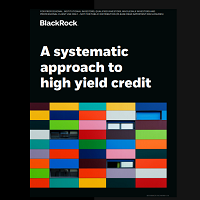FOR INSTITUTIONAL USE ONLY - NOT FOR PUBLIC DISTRIBUTION
Investing involves risk, including possible loss of principal.
Risk warnings
Capital at risk. The value of investments and the income from them can fall as well as rise and are not guaranteed. Investors may not get back the amount originally invested. Past performance is not a reliable indicator of current or future results and should not be the sole factor of consideration when selecting a product or strategy. Changes in the rates of exchange between currencies may cause the value of investments to diminish or increase. Fluctuation may be particularly marked in the case of a higher volatility fund and the value of an investment may fall suddenly and substantially. Levels and basis of taxation may change from time to time and depend on personal individual circumstances.
Important information
This material is for distribution to Professional Clients (as defined by the Financial Conduct Authority or MiFID Rules) only and should not be relied upon by any other persons.
This document is marketing material.
In the U.S., this material is for institutional use only. Not for public distribution.
In Canada, this material is intended for permitted clients as defined under Canadian securities law, is for educational purposes only, does not constitute investment advice and should not be construed as a solicitation or offering of units of any fund or other security in any jurisdiction.
In the UK and Non European Economic Area (EEA) countries: This is issued by BlackRock Investment Management (UK) Limited, authorised and regulated by the Financial Conduct Authority. Registered office: 12 Throgmorton Avenue, London, EC2N 2DL. Tel: + 44 (0)20 7743 3000. Registered in England and Wales No. 02020394. For your protection telephone calls are usually recorded. Please refer to the Financial Conduct Authority website for a list of authorised activities conducted by BlackRock.
In the European Economic Area (EEA): This is issued by BlackRock (Netherlands) B.V. is authorised and regulated by the Netherlands Authority for the Financial Markets. Registered office Amstelplein 1, 1096 HA, Amsterdam, Tel: 020–549 5200, Tel: 31-20-549-5200. Trade Register No. 17068311. For your protection telephone calls are usually recorded. Please refer to the Financial Conduct Authority website for a list of authorised activities conducted by BlackRock.
In the UK and Non-European Economic Area (EEA) countries: this is Issued by BlackRock Investment Management (UK) Limited, authorised and regulated by the Financial Conduct Authority. Registered office: 12 Throgmorton Avenue, London, EC2N 2DL. Tel: + 44 (0)20 7743 3000. Registered in England and Wales No. 02020394. For your protection telephone calls are usually recorded. Please refer to the Financial Conduct Authority website for a list of authorised activities conducted by BlackRock.
In the Kingdom of Saudi Arabia, issued by BlackRock Saudi Arabia, authorised and regulated by the Capital Market Authority (License Number 18- 192-30). Registered office: 7976 Salim Ibn Abi Bakr Shaikan St, 2223 West Umm Al Hamam District Riyadh, 12329 Riyadh, Kingdom of Saudi Arabia, Tel: +966 11 838 3600. CR No, 1010479419. For your protection telephone calls are usually recorded. Please refer to the Capital Market Authority website for a list of authorised activities conducted by BlackRock Saudi Arabia. You may only reproduce, circulate and use this document (or any part of it) with the consent of BlackRock.
In the United Arab Emirates this material is only intended for Professional Investors only. Neither the DFSA or any other authority or regulator located in the GCC or MENA region has approved this information.
In DIFC: The information contained in this document is intended strictly for Professional Clients as defined under the Dubai Finullcial Services Authority ( DFSA ) Conduct of Business (COB) Rules.
In Israel: BlackRock Investment Management (UK) Limited is not licenced under Israel s Regulation of Investment Advice, Investment Marketing and Portfolio Management Law, 5755- 1995 (the Advice Law ), nor does it carry insurance thereunder.
For Qualified Investors in Switzerland: This document shall be exclusively made available to, and directed at, qualified investors as defined in Article 10 (3) of the CISA of June 23, 2006, as amended, at the exclusion of qualified investors with an opting-out pursuant to Art. 5 (1) of the Swiss Federal Act on Financial Services (“FinSA ). For information on art. 8/9 Financial Services Act (FinSA) and on your client segmentation under art. 4 FinSA, please see the following website: www.blackrock.com/finsa.
In South Africa: Please be advised that BlackRock Investment Management (UK) Limited is an authorised Financial Services provider with the South African Financial Services Conduct Authority, FSP No. 43288.
In China, this material may not be distributed to individuals resident in the People s Republic of China (“PRC, for such purposes, not applicable to Hong Kong, Macau and Taiwan) or entities registered in the PRC unless such parties have received all the required PRC government approvals to participate in any investment or receive any investment advisory or investment management services.
In South Korea, this information is issued by BlackRock Investment (Korea) Limited. This material is for distribution to the Qualified Professional Investors (as defined in the Financial Investment Services and Capital Market Act and its sub-regulations) and for information or educational purposes only, and does not constitute investment advice or an offer or solicitation to purchase or sells in any securities or any investment strategies. In Taiwan, independently operated by BlackRock Investment Management (Taiwan) Limited. Address: 28F., No. 100, Songren Rd., Xinyi Dist., Taipei City 110, Taiwan. Tel: (02)23261600.
In Australia & New Zealand, issued by BlackRock Investment Management (Australia) Limited ABN 13 006 165 975, AFSL 230 523 (BIMAL) for the exclusive use of the recipient, who warrants by receipt of this material that they are a wholesale client as defined under the Australian Corporations Act 2001 (Cth) and the New Zealand Financial Advisers Act 2008 respectively.
BlackRock Investment Management (Australia) Limited ( BIMAL”) is not licensed by a New Zealand regulator to provide ‘Financial Advice Service or ‘Keeping, investing, administering, or managing money, securities, or investment portfolios on behalf of other persons . BIMAL’s registration on the New Zealand register of financial service providers does not mean that BIMAL is subject to active regulation or oversight by a New Zealand regulator.
This material provides general information only and does not take into account your individual objectives, financial situation, needs or circumstances. Before making any investment decision, you should therefore assess whether the material is appropriate for you and obtain financial advice tailored to you having regard to your individual objectives, financial situation, needs and circumstances. Refer to BIMAL’s Financial Services Guide on its website for more information. This material is not a financial product recommendation or an offer or solicitation with respect to the purchase or sale of any financial product in any jurisdiction. This material is not intended for distribution to, or use by, any person or entity in any jurisdiction or country where such distribution or use would be contrary to local law or regulation.
BIMAL is a part of the global BlackRock Group which comprises of financial product issuers and investment managers around the world. BIMAL is the issuer of financial products and acts as an investment manager in Australia. BIMAL does not offer financial products to persons in New Zealand who are retail investors (as that term is defined in the Financial Markets Conduct Act 2013 (FMCA)). This material does not constitute or relate to such an offer. To the extent that this material does constitute or relate to such an offer of financial products, the offer is only made to, and capable of acceptance by, persons in New Zealand who are wholesale investors (as that term is defined in the FMCA). BIMAL, its officers, employees and agents believe that the information in this material and the sources on which it is based (which may be sourced from third parties) are correct as at the date of publication. While every care has been taken in the preparation of this material, no warranty of accuracy or reliability is given and no responsibility for the information is accepted by BIMAL, its officers, employees or agents. Except where contrary to law, BIMAL excludes all liability for this information. No part of this material may be reproduced or distributed in any manner without the prior written permission of BIMAL. In Singapore, this is issued by BlackRock (Singapore) Limited (Co. registration no. 200010143N) for use only with institutional investors as defined in Section 4A of the Securities and Futures Act, Chapter 289 of Singapore. This advertisement or publication has not been reviewed by the Monetary Authority of Singapore. In Hong Kong, this material is issued by BlackRock Asset Management North Asia Limited and has not been reviewed by the Securities and Futures Commission of Hong Kong. This material is for distribution to “Professional Investors (as defined in the Securities and Futures Ordinance (Cap.571 of the laws of Hong Kong) and any rules made under that ordinance.) and should not be relied upon by any other persons or redistributed to retail clients in Hong Kong. For Southeast Asia: This document is issued by BlackRock and is intended for the exclusive use of any recipient who warrants, by receipt of this material, that such recipient is an institutional investors or professional/sophisticated/qualified/accredited/expert investor as such term may apply under the relevant legislations in Southeast Asia (for such purposes, includes only Malaysia, the Philippines, Thailand, Brunei and Indonesia). BlackRock does not hold any regulatory licenses or registrations in Southeast Asia countries listed above, and is therefore not licensed to conduct any regulated business activity under the relevant laws and regulations as they apply to any entity intending to carry on business in Southeast Asia, nor does BlackRock purport to carry on, any regulated activity in any country in Southeast Asia. BlackRock funds, and/or services shall not be offered or sold to any person in any jurisdiction in which such an offer, solicitation, purchase, or sale would be deemed unlawful under the securities laws or any other relevant laws of such jurisdiction(s).
This material is provided to the recipient on a strictly confidential basis and is intended for informational or educational purposes only. Nothing in this document, directly or indirectly, represents to you that BlackRock will provide, or is providing BlackRock products or services to the recipient, or is making available, inviting, or offering for subscription or purchase, or invitation to subscribe for or purchase, or sale, of any BlackRock fund, or interests therein. This material neither constitutes an offer to enter into an investment agreement with the recipient of this document, nor is it an invitation to respond to it by making an offer to enter into an investment agreement.
The distribution of the information contained herein may be restricted by law and any person who accesses it is required to comply with any such restrictions. By reading this information you confirm that you are aware of the laws in your own jurisdiction regarding the provision and sale of funds and related financial services or products, and you warrant and represent that you will not pass on or utilize the information contained herein in a manner that could constitute a breach of such laws by BlackRock, its affiliates or any other person.
In APAC: This material is provided for your informational purposes only and must not be distributed to any other persons or redistributed. This material is issued for Institutional Investors only (or professional/sophisticated/qualified investors as such term may apply in local jurisdictions) and does not constitute investment advice or an offer or solicitation to purchase or sell in any securities, BlackRock funds or any investment strategy nor shall any securities be offered or sold to any person in any jurisdiction in which an offer, solicitation, purchase or sale would be unlawful under the securities laws of such jurisdiction. Any research in this document has been procured and may have been acted on by BlackRock for its own purpose. The results of such research are being made available only incidentally. The views expressed do not constitute investment or any other advice and are subject to change. They do not necessarily reflect the views of any company in the BlackRock Group or any part there of and no assurances are made as to their accuracy. This document is for information purposes only and does not constitute an offer or invitation to anyone to invest in any BlackRock funds and has not been prepared in connection with any such offer.
In Latin America, for institutional investors and financial intermediaries only (not for public distribution). This material is for educational purposes only and does not constitute investment advice or an offer or solicitation to sell or a solicitation of an offer to buy any shares of any fund or security and it is your responsibility to inform yourself of, and to observe, all applicable laws and regulations of your relevant jurisdiction. If any funds are mentioned or inferred in this material, such funds may not been registered with the securities regulators of Argentina, Brazil, Chile, Colombia, Mexico, Panama, Peru, Uruguay or any other securities regulator in any Latin American country and thus, may not be publicly offered in any such countries. The securities regulators of any country within Latin America have not confirmed the accuracy of any information contained herein. No information discussed herein can be provided to the general public in Latin America. The contents of this material are strictly confidential and must not be passed to any third party.
In Argentina, only for use with Qualified Investors under the definition as set by the Comisión Nacional de Valores (CNV). In Brazil, this private offer does not constitute a public offer, and is not registered with the Brazilian Securities and Exchange Commission, for use only with professional investors as such term is defined by the Comissão de Valores Mobiliários.
In Chile, the securities if any described in this document are foreign securities, therefore: i) their rights and obligations will be subject to the legal framework of the issuer s country of origin, and therefore, investors must inform themselves regarding the form and means through which they may exercise their rights; and that ii) the supervision of the Commission for the Financial Market (Comisión para el Mercado Financiero or “CMF”) will be concentrated exclusively on compliance with the information obligations established in General Standard No. 352 of the CMF and that, therefore, the supervision of the security and its issuer will be mainly made by the foreign regulator.
In the case of a fund not registered with the CMF is subject to General Rule No. 336 issued by the SVS (now the CMF). The subject matter of this sale may include securities not registered with the CMF; therefore, such securities are not subject to the supervision of the CMF. Since the securities are not registered in Chile, there is no obligation of the issuer to make publicly available information about the securities in Chile. The securities shall not be subject to public offering in Chile unless registered with the relevant registry of the CMF.
In Colombia, the sale of each fund discussed herein, if any, is addressed to less than one hundred specifically identified investors, and such fund may not be promoted or marketed in Colombia or to Colombian residents unless such promotion and marketing is made in compliance with Decree 2555 of 2010 and other applicable rules and regulations related to the promotion of foreign financial and/or securities related products or services in Colombia. With the receipt of these materials, and unless the Client contacts BlackRock with additional requests for information, the Client agrees to have been provided the information for due advisory required by the marketing and promotion regulatory regime applicable in Colombia.
©2025 BlackRock, Inc. or its affiliates. All Rights Reserved. BLACKROCK is a trademark of BlackRock, Inc. or its affiliates. All other trademarks are those of their respective owners.





